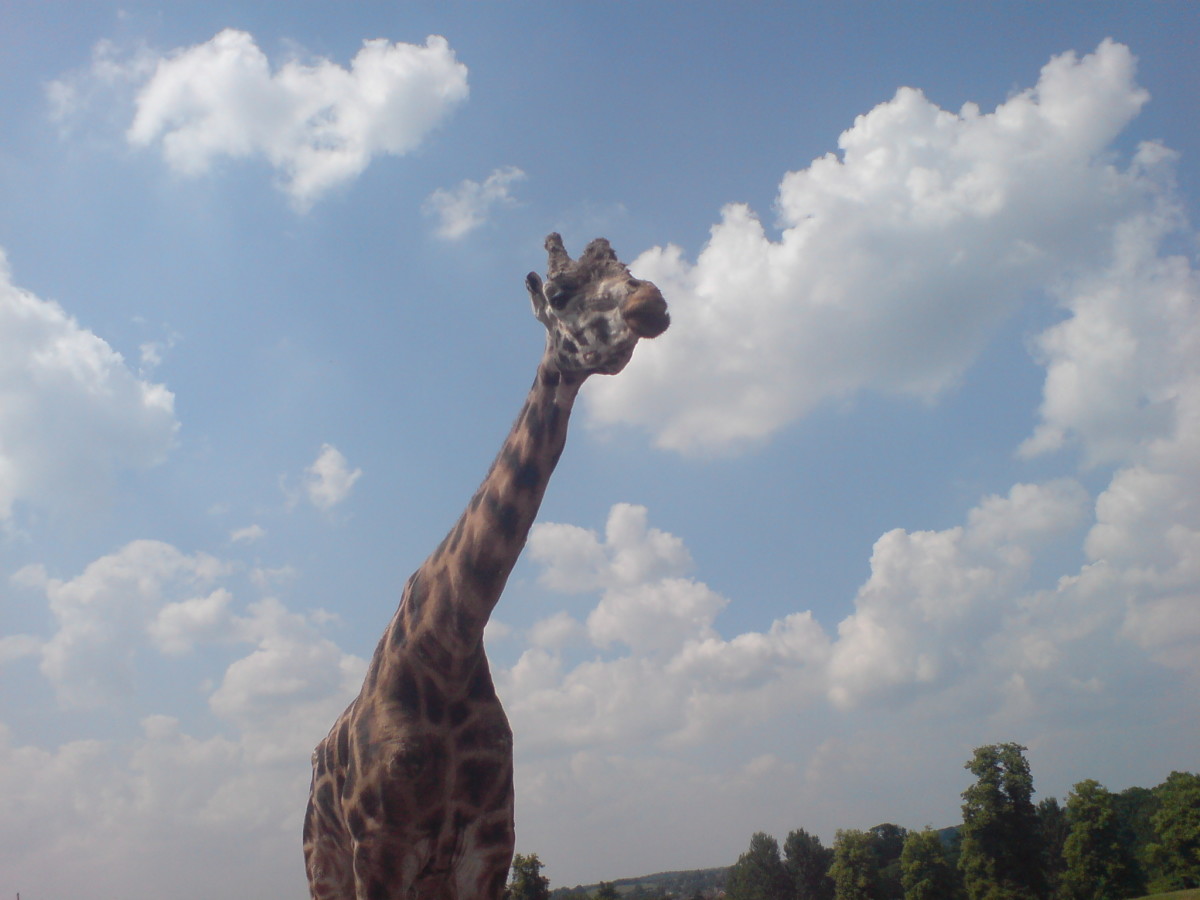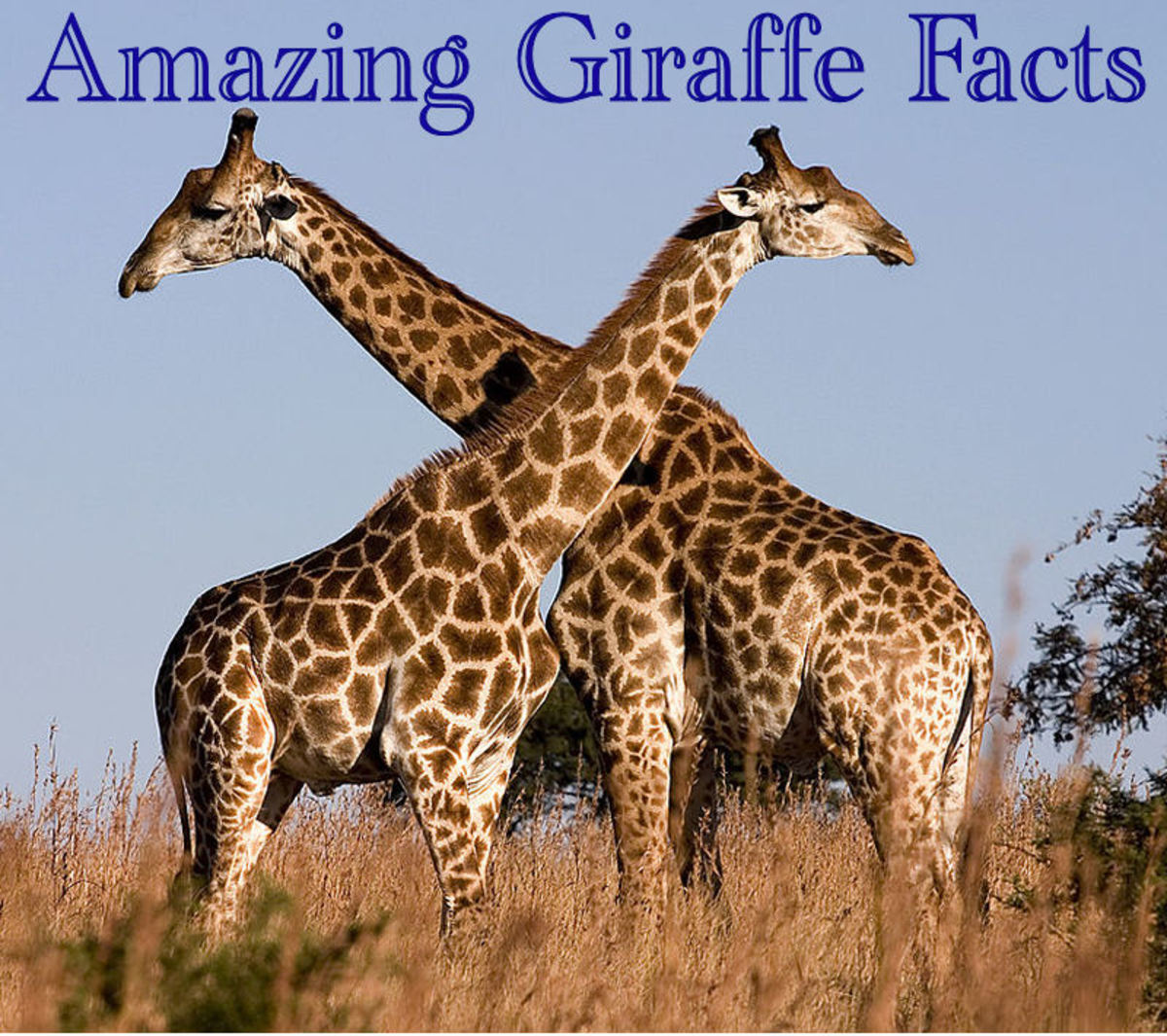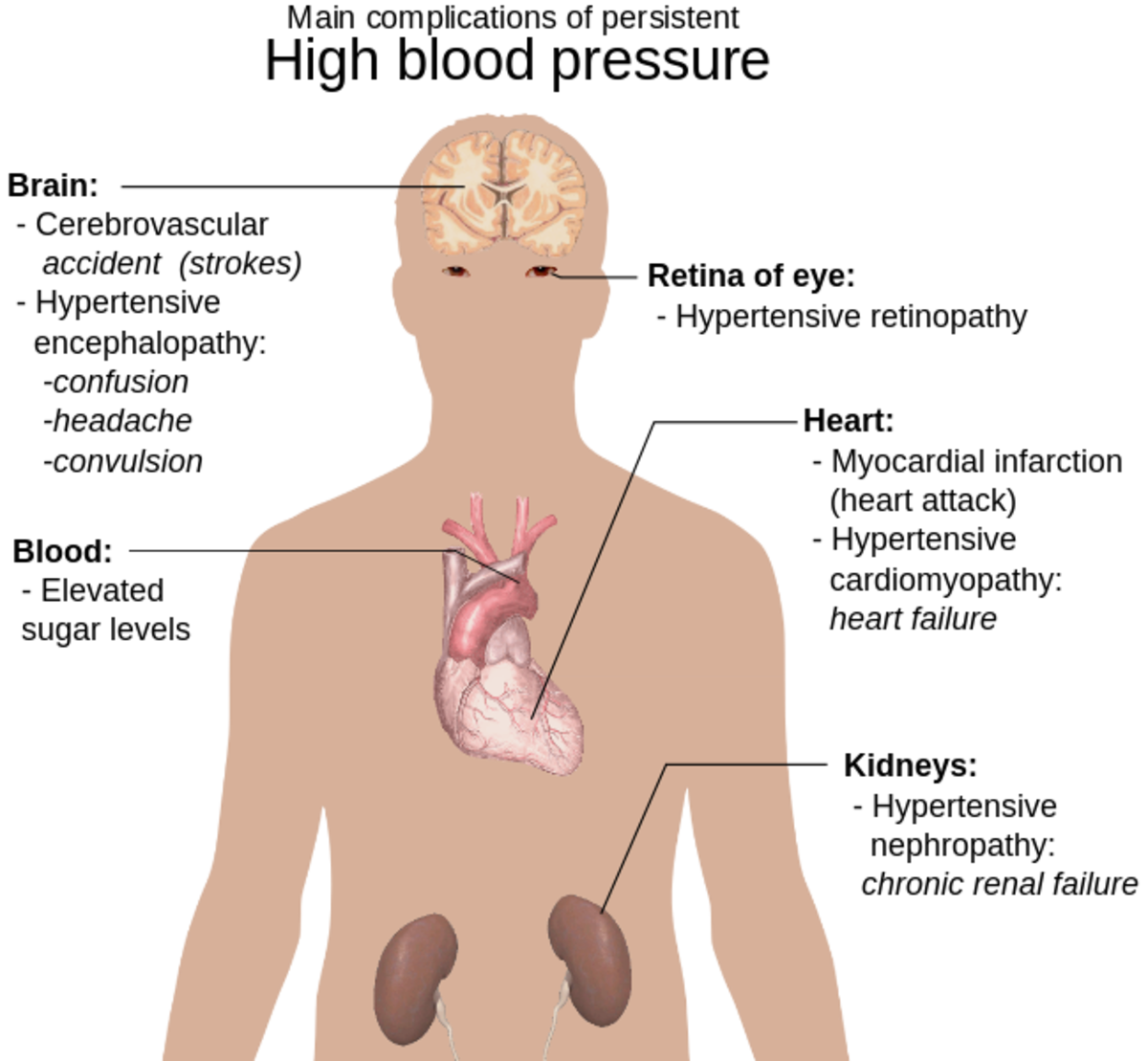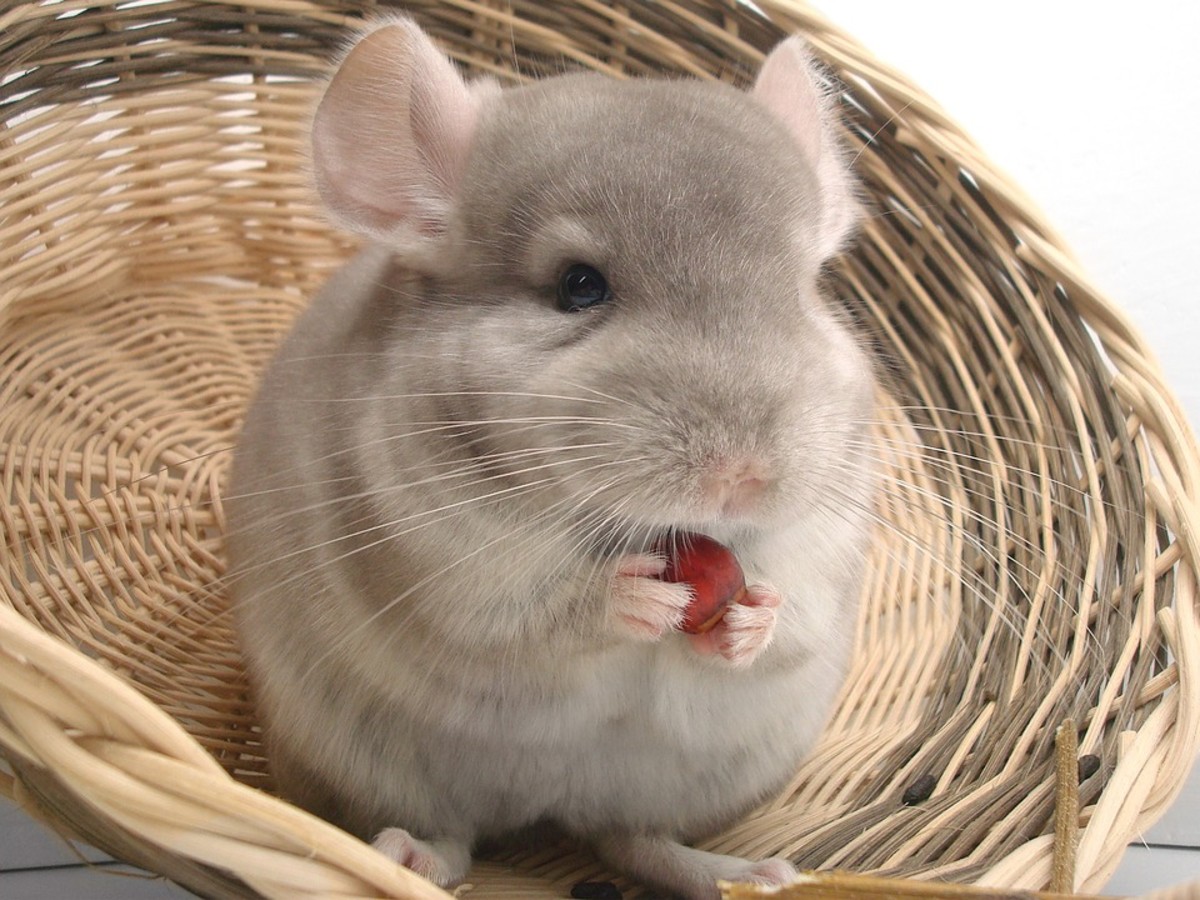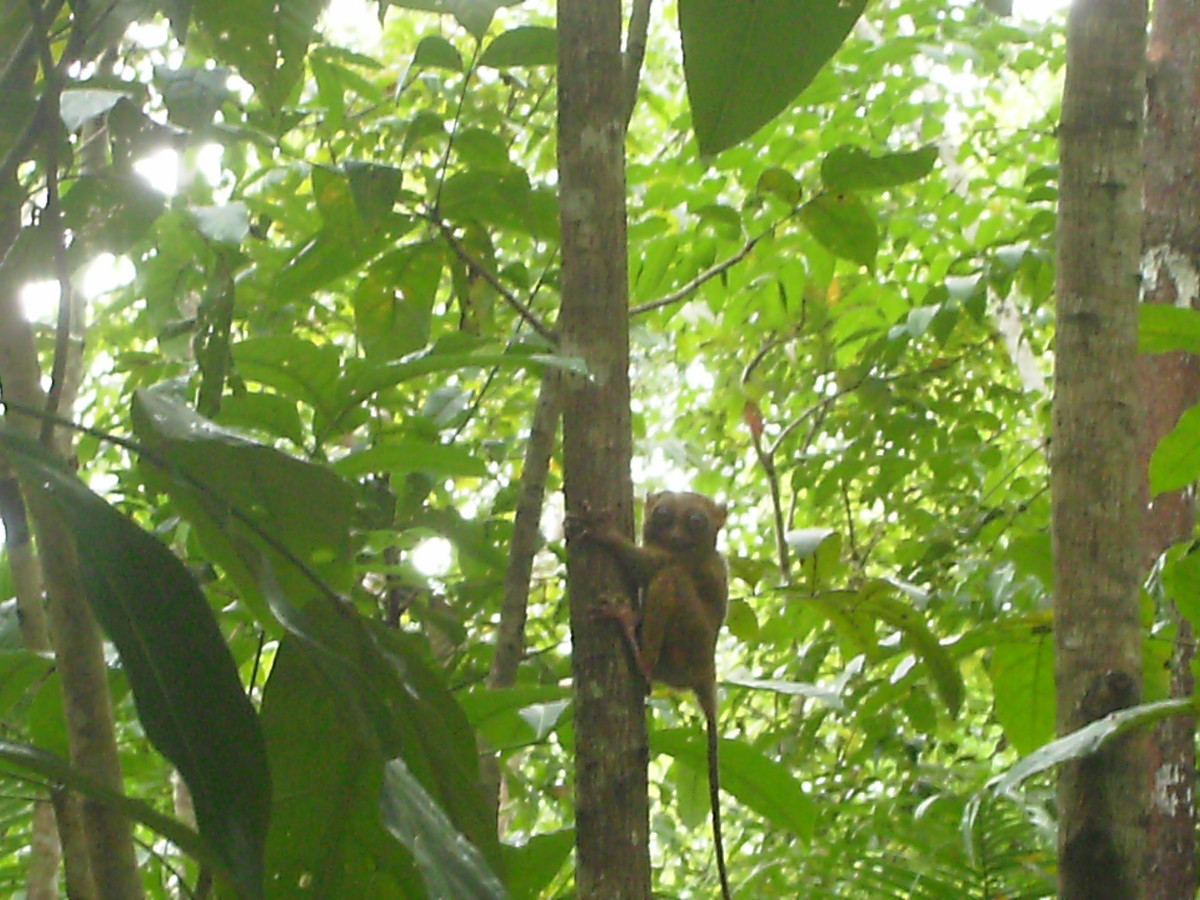about giraffes
Giraffes
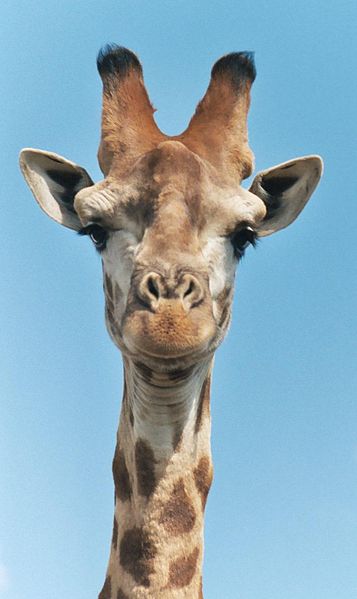
Giraffes - Tallest Mammals on Earth
On rolling grasslands, with scattered shrubs and occasional trees, the tallest mammals on earth, graze on the leaves from treetops in the savanna of Africa.
Towering above all other wildlife, a giraffe's height allows them to scan the landscape for miles. As they survey the land for lions, their main predators, they spend much of their day searching for food. Lions rarely catch giraffes, due to their ability to run fast. When they do encounter a lion, the giraffe is able to deliver devasting blows with their long legs to defend themselves. Their long legs allow them to cruise at 10 miles an hour (16 kilometers), or run as fast as 35 miles (56 kilometers) an hour.
Giraffes and large herds of other hoofed animals roam freely on the arid land of the savannas of Africa. Giraffes in the wild, live only in Africa, where the temperature is warm and very wet in the summer and only slightly cooler and drier in the winter. Zoos all over the world house giraffes, which allows us to see these magnificent animals up close.
Have You Ever Seen a Giraffe Bathe?
Giraffes statistics are staggering and fascinating.
- Giraffes are the tallest land animals on earth.
- Their neck alone is 6 feet long (1.8 meters).
- Their legs are as long as their neck.
- A giraffe's feet are the size of a dinner plate—12 inches across (30.5 centimeters).
- A giraffe's tongue is 18 o 20 inches (46 to 50 centimeters) long and is blue-black in color. Some people think the color is to keep the tongue from getting sunburned.
- Giraffes eat the buds, shoots, fruit and leaves of trees with their prehensile (meaning it can grasp and seize) upper lips.
- Giraffes also eat grains, seeds and low lying vegetation.
- Giraffes can moo, hiss, roar, and whistle.
- A herd of giraffes is led by an old and dominant male, but change herds frequently.
- Giraffes are very shy.
- Giraffes have enormous eyes that sit higher than other animals.
- Giraffes have very long range vision so they can see things from several miles away in sharp detail.
- Giraffes have a keen sense of smell and hearing.
- Giraffes have never been seen to bathe, but the length of their tongue can clean their ears.
- A giraffe's tail can be 31“ to 41” long.
- Their lungs have the capacity to hold 12 gallons (55 liters) of air.
Giraffe Book
About a Giraffe's Heart
A giraffe’s heart weighs 25 pounds (11 kilograms) and is 2 feet long (0.6 meters). A giraffe's heart is 7 cm thick (a little less than 3 inches thick). It is a big problem for the giraffe that their head is 2 meters (over 6 ½ feet) away from their heart.
In order to get blood to their heart, giraffes have extremely high blood pressure (almost 2 times that of humans). Their heart beats 170 times per minute, about twice that of humans. . Their heart is relatively small, but its thick walls help it beat strongly.
Researchers who have studied the cardiovascular system of giraffes believe they adapt to the high blood pressure and it is not a detriment to their health. It seems their blood vessels expand and shrink with the volume of blood that is going through their system.
As a giraffe gets older, the blood vesels thicken to protect any rupturing from the high blood pressure.
Comparison of a Giraffe Heart to a Human Heart
size
| human heart
| giraffe heart
|
|---|---|---|
weight
| 9 oz for an adult female 11 oz for an adult male
| 25 pounds (11 kilograms)
|
relative size to the body
| about the size of your fist
| bigger than their head
|
heart rate (avg number of beats/minute)
| 60-90 beats per minute for adults 40-60 beats per minute for athletes
| 170 times per minute.
|
gallons per minute
| pumps 1 gallon per minute
| The heart pumps about 16 gallons of blood/minute
|
thickness
| left ventricle is thicker than the right and is less than 1/2" thick (1.1 cm thick)
| a little less than 3 inches thick (l7 cm thick)
|
blood pressure
| ranges but 120/80 or less is good normal
| 280/180
|
length
| about 5" long (12.7 cm)
| 2 feet long (0.6 meters)
|
Watch How Giraffes Drink Water
What is your Giraffe I.Q?
view quiz statisticsGiraffes Spend Most of Their Day Looking for Food
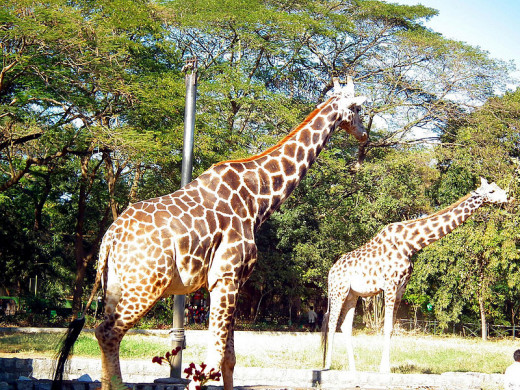
More Facts About Giraffes
Their height gives them the advantage of spotting predators.
Giraffes are easily identified by their long necks, but it is fascinating to know that they have the same number of vertebrae as all other mammals. The difference is that their vertebrae are elongated and attached to each other with ball and socket joint.
A giraffe can eat up to 75 pounds (34 kilograms) of food a day. They spend most of their time eating since they get just a few leaves in every bite they take. The acacia tree has their favorite leaves. The acacia trees have long thorns that stop most animals from eating the leaves.
Because their tongues are so long, they can reach around the thorns. If they accidentally eat any thorns, the sticky saliva on their tongues will coat the thorns. A giraffe's tongue is a dark color and it is thought that may be to protect their tongue from getting sunburned while they reach for the leaves.
Because the acacia leaves are made up in large part of water, they don’t have to drink as often. They only have to drink every couple of days. When giraffes do drink, they bend all the way down to reach the lake or other body of water.
As giraffes bend their neck, they become vulnerable to predators like lions, hyenas, and crocodiles. Giraffes drink as a group so that they can take turns to watch for something that may attack them.
Where water is readily available, a giraffe can drink 10 gallons of water (38 liters) a day. Giraffes, both male and female, have 2 hair covered horns called ossicones. Sometimes they have other bumps that may look like horns, but they are calcium deposits.
Giraffe's in the Wild, Only Live in Central, East and South Africa
Giraffe Gifts
Giraffes and Their Babies
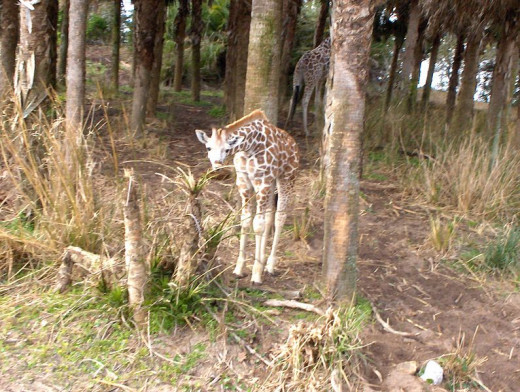
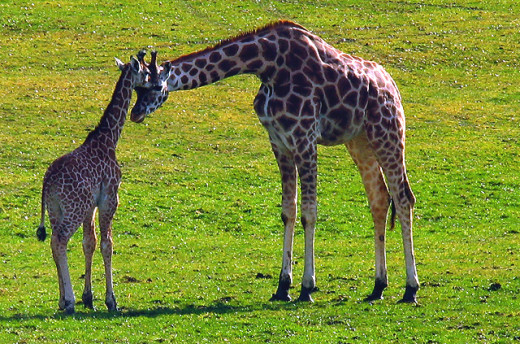
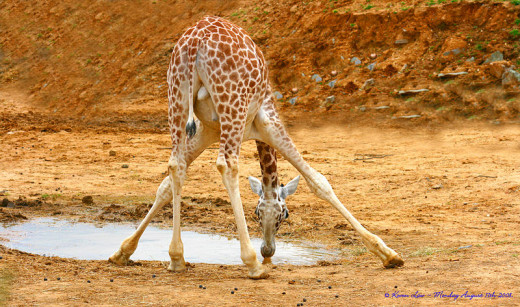
Giraffe Babies Are Six Feet Tall When They are Born
Giraffes are mammals. Their lifespan is approximately 25 years in the wild. They are herbivores and eat leaves
Usually, giraffes can be found roaming in small groups of about 6 giraffes. The male bulls battle each other at times by butting the heads and long necks. While not dangerous to each other, it is done for dominance, and the interaction ends when one of the bulls submits and walks away.
Giraffes are similar to cows in that they regurgitate their food and chew their cud. It takes hundreds of pounds of leaves each week to feed a giraffe. They often travel miles and miles to find enough food for themselves.
At about the age of 6, females usually give birth for the first time. Female giraffes are pregnant for 15 months. The number of young is usually one, but some twins do occur.
A calf is six feet tall at birth and can weigh 150 pounds. They are able to stand after about twenty minutes. Female giraffes give birth while standing up.
The baby falls to the ground at a distance of more than 5 feet (1.5 meters). Ten hours later they are able to run with their mother. Females attain full size by the age of five, and males by the age of seven.
The Pattern of Spots on Giraffes Are Unique
No two giraffes have the same pattern of spots on their coat. Male giraffes weigh more and stand taller than females. Males weigh between 2,400 and 3,000 pounds and stand up to 19 feet tall! Female giraffes weigh between 1,600 and 2,600 pounds and grow to be 16 feet tall.
When giraffes fight among themselves, the males, known as bulls, strike each other with their heads. Giraffes can be seen with impalas, zebras, baboons, and willdebeest.
The word giraffe comes from the Arab word meaning "the one that walks very fast." The species name of the giraffe is called camelopardalis, which means camel leopard. It is derived from the early Roman name.
Similarities and Differences Between Giraffes and Okapi
Giraffe Facts
| Okapi Facts
| Similarities
|
|---|---|---|
Not endangered - saved through conservation efforts
| rare and endangered
| similar body shapes
|
live in dry, arid areas of Africa
| live in rain forests
| both have fur covered horns
|
excellent eyesight
| poor eyesight
| both have 18" long tongues - blue like color
|
prehensile tongue
| ||
both have 32 teeth and in the same pattern in their mouth
| ||
both are shy and non aggressive
| ||
both spread legs outward when they drink water
| ||
dominance displays for both okapi and giraffe involve nose pointing away from the body's midline, which increases the visual impact of neck length
| ||
like giraffes, okapis use long, prehensile tongue to pull leaves off branches; a slender muzzle and flexible lips also help with choosing the "right" plantsl
| ||
both don't have gall bladders
|
Okapi Have Some Similarities to Giraffes
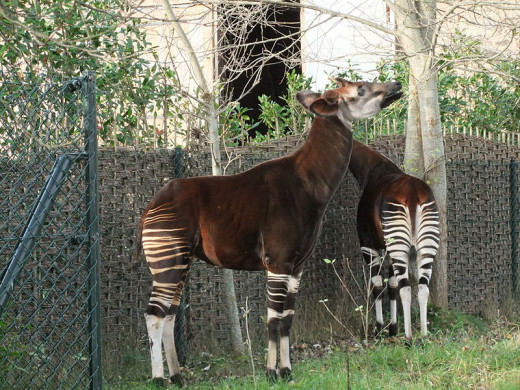
Okapi is a Close Relative of the Giraffe
The okapi is the only close relative of the giraffe. They are rare and endangered. Okapi share a similar body shape to the giraffe, except they are much shorter in height, and have much shorter necks. They have distinctive fur covered horns (only seen in males) and they have special teeth, and tongue.
Giraffes are not endangered but they have lost some of their habitat and conservation efforts are helping the species.
We humans are very curious about giraffes.
They are a biological marvel that leave much more for us to study and learn about these amazing animals.
More Animal Articles from ToKnowInfo
- Butterflies - Winged Wonders - A Gift of Nature
I have entomophobia. It is caused by bugs. But don’t worry. It is nothing serious. Entomophobia is the fear of bugs. Yet, I am not afraid of butterflies, ladybugs, grasshoppers and praying mantis And on occasion, when I have to be brave for my... - Animalology: Dolphins - Social Animals of the Sea - ...
In a spontaneous moment we took a private charter, just my family, and a man who owned a boat. He claimed he knew where the dolphins played and would take us to see them in pods of 50 to 60 where they lived in the freedom of the ocean. It was a... - Sea Turtles - Preserving Protecting and Sharing the ...
They roam the warm and temperate waters of the world for the nearly 8 -10 decades of their nomadic existence. As ancient creatures of the sea, their ancestry takes them back 150 million years ago, to the later Jurassic time period, where sea turtles. - Animalogy: Magnetite - How Animals Find their Way A...
Birds. butterflies, bats, turtles and many other animals roam the skies and float across the open waters of the globe, travelling thousands of miles to their destinations. These animals never stray off course, lose their direction, or end up in the.. - How Smart are Elephants? Intellect, Social Life, ...
What do human beings, dolphins, great apes and elephants have in common? As far as science has studied, these mammals are part of an exclusive group of animals who can recognize themselves in the mirror. Scientists at The Wildlife Conservation... - Dogs and Cold Weather - How Dogs Stay Warm - It is M...
The Amazing Fur of Dogs Most dogs do well in cold weather. Most canines that live in cold weather areas have thicker coats and are larger dogs. But there is more than just their fur that helps them stay warm. Dogs do well in cold weather, in... - How to Teach Children to Care for Pets
What would you do to make sure your child grows up with a strong self esteem, to be a mature, responsible adult, who is compassionate, and kind to others? While there is no magic formula, it seems that children who grow up taking care of a pet may... - Bunny Moments: Pleasures and Perils of Owning and Ca...
What do you need to know before you adopt a bunny rabbit? The Unconditional Love of Having a Bunny Among my menagerie of pets, I have a sweet rabbit named Peaches. He is a long floppy eared bunny, also known as a French Lop Rabbit. He fits in our... - A Puppy Sells for $1.5 Million - Dollars for Dogs - ...
What is the most expensive breed of dog? An 11 month old puppy that weighs 180 pounds just sold for $1.5 million. The dog is a red Tibetan mastiff, and was sold to a Chinese a multimillionaire businessman, a coal baron from Northern China. The... - Dogology: Dogs Uncanny Intelligence
Dogology: Dogs Uncanny Intelligence and Social Behavior In this article: · Dogs behavior and their natural social instinct · Apes vs Dogs · Dogs sensitivity towards people · Evolutionary Explanations · What people can learn from... - Dogology: Why are Dogs so Different in Shapes Sizes ...
Dogology: Lovable Dogs in Different Shapes Sizes Types Canines are all the same species but look so different: WHY? What’s in this article: · Dogs in all different sizes · All dogs have the same ancestor · History of the dog ·... - Peoplality: Big 5 Personality Traits and Their Pets
Every aspect of our lives has a connection to our personality. From the clothes we wear, the profession we engage in, and even the pets we love say something about our personality. A common theory about personality is known as the The Big 5... - Can Animals Predict Natural Disasters: Petology - th...
Do animals have a sixth sense to be able to predict earthquakes? Earthquakes, tsunamis, volcanic eruptions, hurricanes, tornadoes, landslides, forest fires, storms, and the list goes on. These are the natural disasters that make headlines too often..




